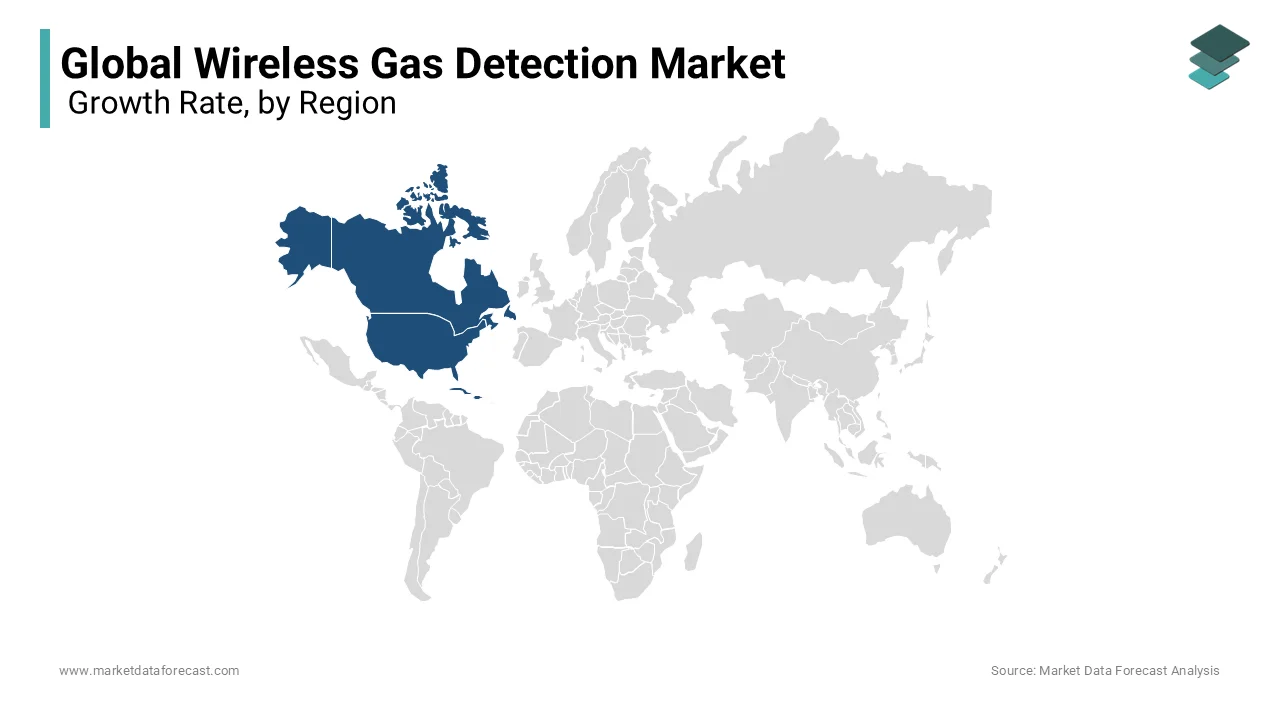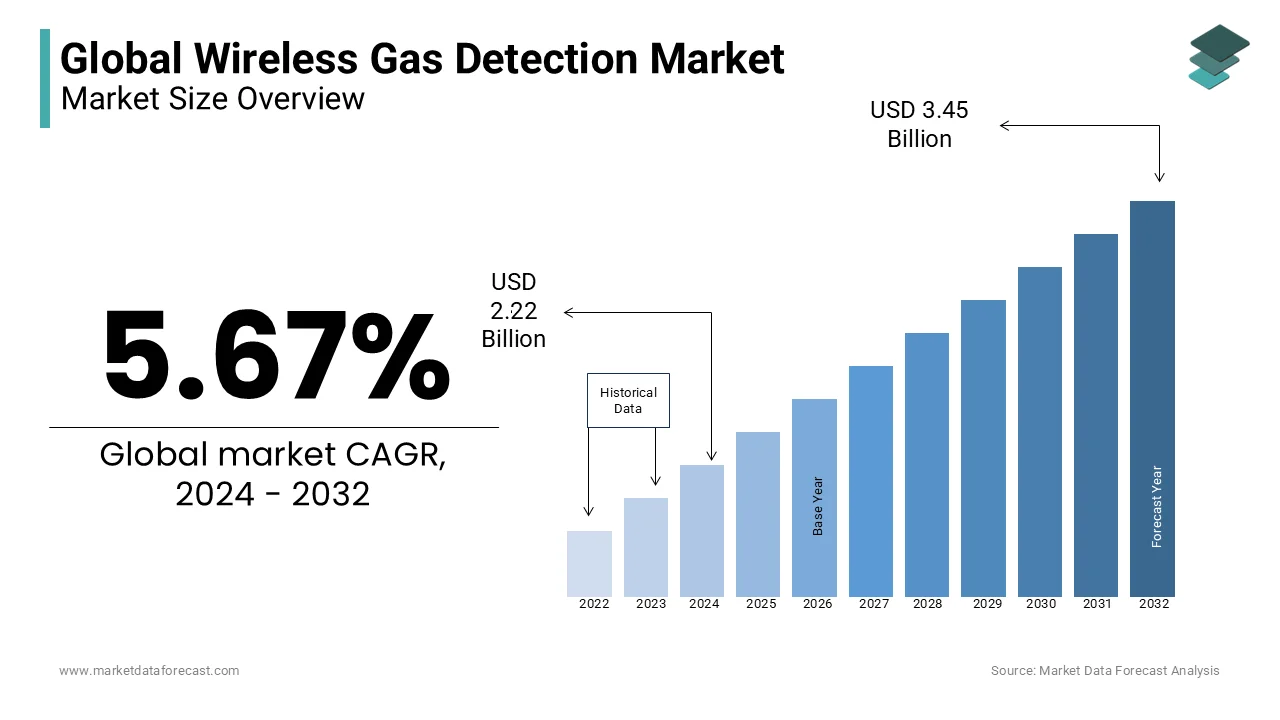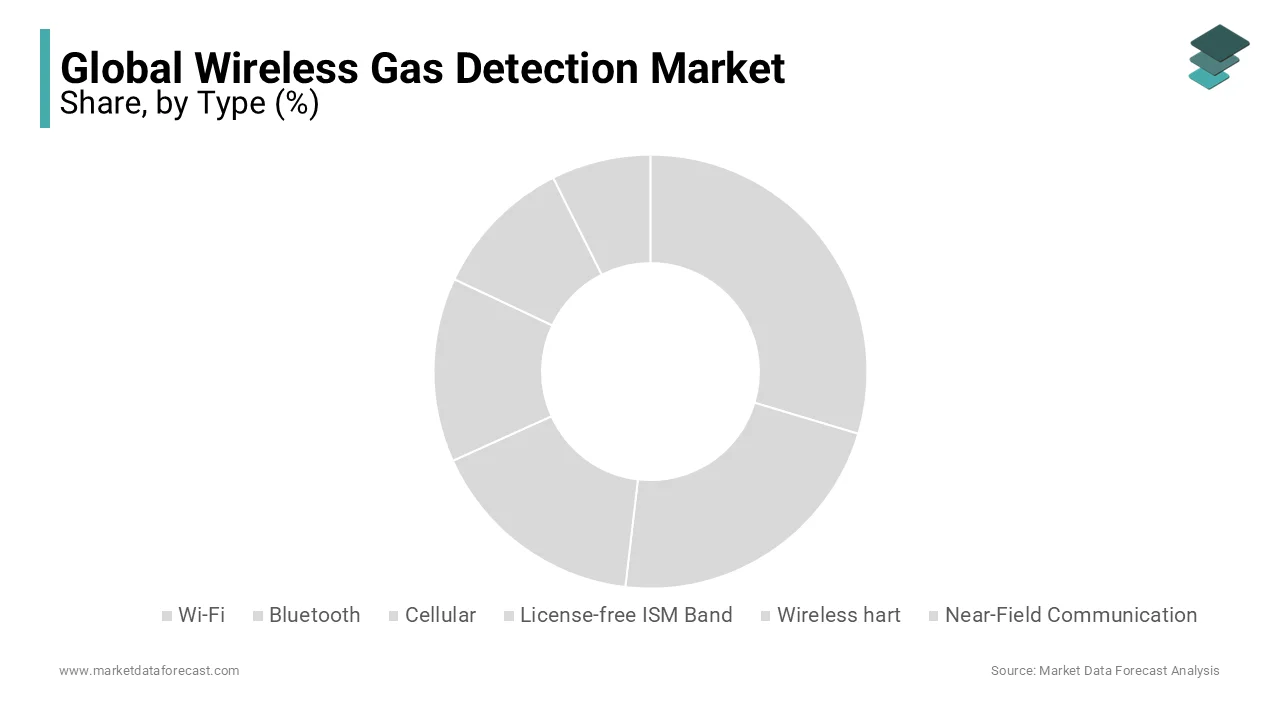Global Wireless Gas Detection Market Research Report - Segmented by Technology (Bluetooth, Wi-fi, Cellar, Others), by Type (Software, Services, Hardware (Detectors/ Sensors, Monitors, Gateways, and Controllers)), by Applications (government & military, commercial buildings & public facilities, manufacturing industries, mining & metals, utilities & power generation, oil & gas, chemical & petrochemicals and others), Regional analysis- Global Industry Analysis, Forecast, Trends and Market Size Forecast 2024–2032.
Global Wireless Gas Detection Market Size (2024 to 2032):
The Global Wireless Gas Detection Market was worth USD 2.10 billion in 2023 and is anticipated to reach a valuation of USD 3.45 billion by 2032 from USD 2.22 billion in 2024. It is predicted to register a CAGR of 5.67% during the forecast period 2024-2032.
Wireless gas detection is a part of the safety system that helps to detect the presence of gases in the environment and surroundings. It also detects the leakages of toxic gases and explosives in industries. The detector is connected to the control system, which works automatically to shut down the process in case of leakage.
MARKET DRIVERS
The market's driving factor is the rise in the use of wireless gas detectors in the chemical industry.
The chemical industry is one of the highest users of wireless gas detectors due to the constant requirement to check gas leakages and associated safety risks. The advantages of wireless gas detectors are several over the traditional wired system that, includes easier installation, low cost, low maintenance, and can detect gas leakages remotely. These benefits have increased the demand for wireless gas detection in places where safety is given top priority, like the chemical industry. The various application in the chemical industry, like oil and gas exploration and production, petrochemical manufacturing, and storage and transportation of chemicals, would drive the wireless gas detection market. These detectors provide real-time data and alert indications to prevent accidents and reduce the risk of exposure. The rise in the usage of wireless gas detection in the chemical industry is a driving factor for market growth.
The rise in technological advancements would be a market driver.
Cloud-based analytics, Internet of Things (IoT) sensors, and artificial intelligence (AI) developments in advanced wireless gas detection are additionally accelerating the market's demand. These advantages include improved accuracy, reliability, and ease of use compared to traditional wired systems. The cost-effective feature and increased demand in emerging countries led to the growth of the wireless gas detection market.
MARKET RESTRAINTS
The high cost of the product would restrain the adoption of the product across the world. Small-scale industries find it difficult to manufacture wireless gas detectors due to the high investment because of financial constraints. The wireless gas detectors market finds it difficult to develop with the rapidly evolving industry standards. The weak infrastructure available in nations with low and medium economies would be a challenging factor in the adoption of the product. Radiofrequency technology is used to transmit the data, but the range of the signals is limited, and reduction in the signal strength because of obstacles restrains the market. False alarms can be noticed during adverse environmental conditions like humidity and temperature changes. Lack of standardization in the wireless gas detection battery varies in the battery life because of the dependence on the frequency and transmission of the data, type of the gas, and environmental conditions.
MARKET OPPORTUNITIES
The rise in accidents at the manufacturing units has a significant opportunity for the wireless gas detection market. The government also increased the rules and regulations regarding the worker’s safety will be boosting to the market growth. The increased adoption of advanced technology like AI, IoT, etc., will be an opportunity for the expansion of the market to reach the demands of the various customers in the wireless detection market. The feature of remote sensing can be used as an opportunity to expand to the various sectors. Increasing investments in the oil and gas industries, which is one of the most demanding sectors, will propel the wireless gas detection market in developing countries in the coming years. The rise in the adoption of wireless communication Wi-Fi, Bluetooth, and Wireless HART is creating opportunities for wireless gas detection systems, as they offer real-time monitoring and alerts.
REPORT COVERAGE
|
REPORT METRIC |
DETAILS |
|
Market Size Available |
2023 to 2032 |
|
Base Year |
2023 |
|
Forecast Period |
2024 to 2032 |
|
CAGR |
5.67% |
|
Segments Covered |
By Type, Component and Service, Application, End Users, and Region. |
|
Various Analyses Covered |
Global, Regional, & Country Level Analysis; Segment-Level Analysis, DROC, PESTLE Analysis, Porter’s Five Forces Analysis, Competitive Landscape, Analyst Overview of Investment Opportunities |
|
Regions Covered |
North America, Europe, APAC, Latin America, Middle East & Africa |
|
Market Leaders Profiled |
Siemens AG, Yokogawa Electric Corporation, United Electric Control, Crowcon Detection Instruments Ltd., and Airtest Technologies Inc. Honeywell International Inc., Tyco Gas and Flame Detection, Gastronics Inc., Drägerwerk AG & Co, KGaA, and Others. |
SEGMENTAL ANALYSIS
Global Wireless Gas Detection Market Analysis By Type
The Wi-Fi type is expected to have the highest market share in the wireless gas detection market during the forecast period. The wide application of Wi-fi is seen in various industries like oil and gas, chemical, and manufacturing, where there is high data transfer, reliability, and security features are required. Wi-fi-enabled wireless gas detection systems allow real-time monitoring and alert indication are given, and this application makes them popular in various fields. Other types, such as Bluetooth, cellular, and wireless HART, are also gaining importance due to their specific advantages and wide applications.
Global Wireless Gas Detection Market Analysis By Component and Service
The hardware category is expected to have a high market share in the component and service segment in the wireless gas detection market. Due to the increased demand for wireless gas detection sensors hardware segment will continue to have dominant in the market. Various hardware components include sensors, controllers, transmitters, and detecting devices used in the detection and monitoring of harmful gases. The service category is the next expected high share in the market due to the increasing need for the regular maintenance of wireless gas detection systems.
Global Wireless Gas Detection Market Analysis By Application
Industrial safety is expected to have high market value in the wireless gas detection market due to its continued use in the monitoring of hazardous gases in various industries, which comes under industrial safety, which is a primary application of wireless gas detection systems. National security and military safety are the next high-market value segment. The detection of toxic gases and chemicals in military and homeland security is the major important application of wireless gas detection systems.
Global Wireless Gas Detection Market Analysis By End Users
The oil & gas industry is expected to have high market growth in the end-user segment during the forecast period. The increase in the use of wireless gas detection is seen more in residential and commercial areas. To ensure the safety of the workers and environment, continuous monitoring of the hazardous gases in the oil refineries and offshore drilling rigs is carried out using wireless gas detection systems. The major application in the chemical and petrochemical industry is the monitoring of hazardous gases in the manufacturing and storage process.
REGIONAL ANALYSIS

North America is the major region with high market growth features in the wireless gas detection market during the forecast period. The government had implemented strict regulations and guidelines for industrial safety in the region is a favorable factor driving the market. The oil and gas industry is the major end-user in the market of this region. Europe is another significant region for the market. The presence of several chemical and petrochemical industries is a driving factor for the market.
KEY PLAYERS IN THE GLOBAL WIRELESS GAS DETECTION MARKET
Companies playing a prominent role in the global wireless gas detection market include Emerson Electric Co., Honeywell International Inc., Yokogawa India Ltd., Crowcon Detection Instruments., Teledyne Technologies Incorporated, Siemens, Tek Troniks Limited, United Electric Controls, Ambetronics Engineers Pvt.Ltd, Global Detection Systems Corp, and Others.
RECENT HAPPENINGS IN THE GLOBAL WIRELESS GAS DETECTION MARKET
- In 2020, the Vanguard wirelessHART gas detector of the United Electric Controls now HART registered. In the world, there are more than 40 million field instruments supporting HART technology in process industries.
DETAILED SEGMENTATION OF THE GLOBAL WIRELESS GAS DETECTION MARKET INCLUDED IN THIS REPORT
This research report on the global wireless gas detection market has been segmented and sub-segmented based on type, component and service, application, end users, and region.
By Type
- Wi-Fi
- Bluetooth
- Cellular
- License-free ISM Band
- Wireless hart
- Near-Field Communication
By Component and Service
- Hardware
- Software
- Services
By Application
- Industrial Safety
- National Security and Military Safety
- Environmental Safety
By End Users
- Oil and Gas
- Chemical and Petrochemical
- Utilities and Power Generation
- Mining and Metals
- Water and Wastewater Treatment Plants
- Commercial Buildings and Public Facilities
- Government and Military
- Discrete Manufacturing Industries
- Others
By Region
- North America
- Europe
- Asia Pacific
- Latin America
- Middle East & Africa
Frequently Asked Questions
What is the key driving factor in Wireless Gas Detection Market?
The rise in the usage of wireless gas detectors in the chemical industry and the rise in technological advancements are the key driving factors in the market.
Which region is expected to have a market growth opportunity?
The North American region is expected to have market growth opportunities.
What is the restraining factor in the Wireless Gas Detection Market?
The high cost of the product is a major restraining factor in the market.
Related Reports
Access the study in MULTIPLE FORMATS
Purchase options starting from $ 2500
Didn’t find what you’re looking for?
TALK TO OUR ANALYST TEAM
Need something within your budget?
NO WORRIES! WE GOT YOU COVERED!
Call us on: +1 888 702 9696 (U.S Toll Free)
Write to us: [email protected]

